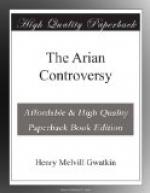[Sidenote: First exile of Athanasius.]
Meanwhile Constantine’s dreams of peace were rudely dissipated by the sudden appearance of Athanasius before him in the streets of Constantinople. Whatever the bishops had done, they had plainly caused dissensions just when the Emperor was most anxious for harmony. An angry letter summoned the whole assembly straight to court. The meeting, however, was most likely dispersed before its arrival; at any rate, there came only a deputation of Eusebians. The result was unexpected. Instead of attempting to defend the council of Tyre, Eusebius of Nicomedia suddenly accused Athanasius of hindering the supply of corn for the capital. This was quite a new charge, and chosen with much skill. Athanasius was not allowed to defend himself, but summarily sent away to Trier in Gaul, where he was honourably received by the younger Constantine. On the other hand, the Emperor refused to let his place be filled up at Alexandria, and exiled the Meletian leader, John Archaph, ‘for causing divisions.’ To Constantinople came also Marcellus. He had kept away from the councils of Tyre and Jerusalem, and only came now to invite the Emperor’s decision on his book. Constantine referred it as usual to the bishops, who promptly condemned it and deposed its author.
[Sidenote: Death of Arius.]
There remained only the formal restoration of Arius to communion at Constantinople. But the heretic was taken ill suddenly, and died in the midst of a procession the evening before the day appointed. His enemies saw in his death a judgment from heaven, and likened it to that of Judas. Only Athanasius relates it with reserve and dignity.
[Sidenote: Policy of Constantine.]
Upon the whole, Constantine had done his best for peace by leaving matters in an uneasy suspense which satisfied neither party. This seems the best explanation of his wavering. He had not turned Arian, for there is no sign that he ever allowed the decisions of Nicaea to be openly rejected inside the churches. Athanasius was not exiled for heresy, for there was no question of heresy in the case. The quarrel was ostensibly one of orthodox bishops, for Eusebius had signed the Nicene creed as well as Athanasius. Constantine’s action seems to have been determined by Asiatic feeling. Had he believed the charge of delaying the corn-ships, he would have executed Athanasius at once. His conduct does not look like a real explosion of rage. The merits of the case were not easy to find out, but the quarrel between Athanasius and the Asiatic bishops was a nuisance, so he sent him out of the way as a troublesome person. The Asiatics were not all of them either Arians or intriguers. It was not always furtive sympathy with heresy which led them to regret the heresiarch’s expulsion for doctrines which he disavowed; neither was it always partizanship which could not see the innocence of Athanasius. Constantine’s vacillation is natural if his policy was to seek for unity by letting the bishops guide him.




